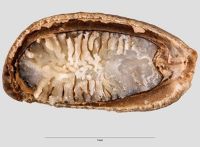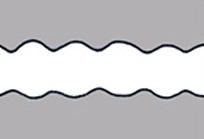Content is from Kirkbride et al. 2006Kirkbride et al. 2006:
Kirkbride JH, Jr, Gunn CR, and Dallwitz MJ. 2006. Family guide for fruits and seeds, vers. 1.0. Accessed September 2020-January 2022. URL: https://nt.ars-grin.gov/seedsfruits/keys/frsdfam/index.cfm ., without modification.
Updates are forthcoming.
Fruits: Pistil(s) compound (Rhopalocarpus), or simple (Dialyceras); 1, or 2–5; 1–4-pistillate; with carpels separate to base, or carpels united. Fruit pericarpium; simple (Rhopalocarpus), or multiplemultiple:
fruit formed from several flowers clustered in one mass
(Dialyceras); carceruluscarcerulus:
simple, multicarpellate, indehiscent fruit consisting of one or more seeds and air space enclosed by an undifferentiated pericarp (Spjut 1994)
(Rhopalocarpus); achenetum (Dialyceras); without persistent central column; without stylestyle:
in a flower, the narrow and elongated part of the pistil between the stigma and the ovary; sometimes persisting in fruit or stylar remnants; not within accessory organ(s); 1-seeded, or more than 1 but less than 10-seeded; 1–4-seeded; from 1–5 cm long; 1.5–2 cm long; with 1–4-carpellate; with carpels united (Rhopalocarpus), or separate (Dialyceras); with carpels remaining united at maturity (Rhopalocarpus); with carpels not radiating at maturity (Rhopalocarpus), or radiating at maturity (Dialyceras); with carpels remaining connected at stylestyle:
or stylar remnants; not within accessory organ(s); 1-seeded, or more than 1 but less than 10-seeded; 1–4-seeded; from 1–5 cm long; 1.5–2 cm long; with 1–4-carpellate; with carpels united (Rhopalocarpus), or separate (Dialyceras); with carpels remaining united at maturity (Rhopalocarpus); with carpels not radiating at maturity (Rhopalocarpus), or radiating at maturity (Dialyceras); with carpels remaining connected at stylestyle:
in a flower, the narrow and elongated part of the pistil between the stigma and the ovary; sometimes persisting in fruit ; without sterilesterile:
; without sterilesterile:
lacking male and/or female reproductive parts; also, not producing fruit or seed
 carpels, or with sterilesterile:
carpels, or with sterilesterile:
lacking male and/or female reproductive parts; also, not producing fruit or seed
 carpels; without fleshy laterallateral:
carpels; without fleshy laterallateral:
(of embryo) embryo lies along the side of the seed, generally towards one end; of, at, or from the side; in grasses, can refer to the sides adjacent to the dorsal and ventral sides
appendage; not sulcatesulcate:
surface relief—having one or more elongate, relatively narrow and shallow depressions or grooves ; in transection tereteterete:
; in transection tereteterete:
approximately circular in cross section; width and thickness approximately equal
 ; apexapex:
; apexapex:
the point farthest from the point of attachment, or the "tip" of an organ not beakedbeak:
not beakedbeak:
a usually firm, terminal appendage, sometimes tapered (Rhopalocarpus), or beakedbeak:
(Rhopalocarpus), or beakedbeak:
a usually firm, terminal appendage, sometimes tapered (Dialyceras); apexapex:
(Dialyceras); apexapex:
the point farthest from the point of attachment, or the "tip" of an organ moderately beaked; wall fleshy to hard; indehiscentindehiscent:
moderately beaked; wall fleshy to hard; indehiscentindehiscent:
not opening on its own, as in a fruit
 . Epicarpepicarp:
. Epicarpepicarp:
outer layer of fruit wall or pericarp, if divided into layers; note here used synonymously with exocarp brown (all shades); dulldull:
brown (all shades); dulldull:
reflecting only a low proportion of incident light, with no apparent sheen ; durable; hard; glabrousglabrous:
; durable; hard; glabrousglabrous:
without hairs
; without armature; not smooth (Rhopalocarpus), or smooth (Dialyceras); muricatemuricate:
surface relief—rough with small, hard, sharp projections
; without wing(s); without apicalapical:
at or pertaining to the end of the seed or fruit distal from its point of attachment (i.e., base)
respiratory hole. Mesocarpmesocarp:
the middle layer of the pericarp, if divided into layers present; hard; composed of 1 unified layer; without lactiform cavity system; & endocarpendocarp:
present; hard; composed of 1 unified layer; without lactiform cavity system; & endocarpendocarp:
the inner layer of the pericarp, if divided into layers sharply differentiated. Endocarpendocarp:
sharply differentiated. Endocarpendocarp:
the inner layer of the pericarp, if divided into layers present; not separating from exocarpexocarp:
present; not separating from exocarpexocarp:
outer layer of fruit wall or pericarp, if divided into layers; note here used synonymously with epicarp ; firm; not splitting into 1-seeded pyrenes; without wing; without operculumoperculum:
; firm; not splitting into 1-seeded pyrenes; without wing; without operculumoperculum:
a dehiscent cap (or lid) of a seed or fruit that opens during germination or dehiscence ; without secretory cavities; without mechanism for seedling escape; without grooves; without longitudinallongitudinal:
; without secretory cavities; without mechanism for seedling escape; without grooves; without longitudinallongitudinal:
of or relating to length or the lengthwise dimension
ridges.
Seeds: Arilaril:
(broad sense) appendicular structure that wholly or partly envelops a seed and is produced from or a modification of the funicle, raphe, or outer integument; usually fleshy or pulpy, sometimes spongy or tufted-capillate, often brightly colored absent. Seed larger than minute; 10 to less than 25 mm long; 16 mm long; ovateovate:
absent. Seed larger than minute; 10 to less than 25 mm long; 16 mm long; ovateovate:
2D shape—egg-shaped in outline, widest point is towards one end of the organ, the other end tapers gradually, attachment at or near the broad end (compare obovate, ovoid) ; in transection tereteterete:
; in transection tereteterete:
approximately circular in cross section; width and thickness approximately equal
 ; not bowl shaped; not nutlike; without winglike beakbeak:
; not bowl shaped; not nutlike; without winglike beakbeak:
a usually firm, terminal appendage, sometimes tapered ; without caudatecaudate:
; without caudatecaudate:
tapering to a long, tail-like appendage appendage(s); at maturity with food reserves; with endosperm; without canavanine. Sarcotestasarcotesta:
appendage(s); at maturity with food reserves; with endosperm; without canavanine. Sarcotestasarcotesta:
pulpy or fleshy outer layer of the seed coat, simulates aril absent. Testatesta:
absent. Testatesta:
seed coat
 present; without markedly different marginalmarginal:
present; without markedly different marginalmarginal:
at, on, or close to the margin or border
tissue; without pellicle layer; without fleshy or leatheryleathery:
texture—moderately thick, tough, and very pliable
layer over hard layer; tight; dulldull:
reflecting only a low proportion of incident light, with no apparent sheen ; surface smooth; without crease or line separating cotyledons from hypocotyl-radicle; without notch along margin where cotyledons from hypocotyl-radicle tip approach each other; without glands; without bristles; glabrousglabrous:
; surface smooth; without crease or line separating cotyledons from hypocotyl-radicle; without notch along margin where cotyledons from hypocotyl-radicle tip approach each other; without glands; without bristles; glabrousglabrous:
without hairs
; without wings; without collar; without operculumoperculum:
a dehiscent cap (or lid) of a seed or fruit that opens during germination or dehiscence ; colored; monochrome; brown (all shades); hard; not becoming mucilaginousmucilaginous:
; colored; monochrome; brown (all shades); hard; not becoming mucilaginousmucilaginous:
resembling mucilage; moist and sticky
when wetted; surrounding embryo. Hilumhilum:
on seeds, the scar indicating where the funiculus was attached; on grass caryopses, the scar visible on the outer fruit surface revealing where the seed is attached on the inner fruit wall surface; or in Asteraceae cypselae, the scar visible on the outer fruit wall revealing where the fruit was attached to the receptacle larger than punctatepunctate:
larger than punctatepunctate:
surface relief - dotted with pits or with translucent, sunken glands or with colored dots, similar to pitted ; marginalmarginal:
; marginalmarginal:
at, on, or close to the margin or border
; ellipsoidalellipsoid:
3D shape—elliptic
. Rapheraphe:
a ridge or seam on the seed coat, formed by the portion of the funiculus united to the ovule wall in longitudinally curved ovules conspicuous. Endosperm moderate; smooth, or ruminateruminate:
conspicuous. Endosperm moderate; smooth, or ruminateruminate:
testa or seed coat folded into the endosperm ; without fatty acid containing cyclopropene; without chlorophyll; without odor. Embryo differentiated from food reserve; well developed; 1 per seed; partially filling testatesta:
; without fatty acid containing cyclopropene; without chlorophyll; without odor. Embryo differentiated from food reserve; well developed; 1 per seed; partially filling testatesta:
seed coat
 (with food reserve), or nearly filling testatesta:
(with food reserve), or nearly filling testatesta:
seed coat
 (trace or scanty food reserve); at one end of seed not extending into a depression or cup; axileaxile:
(trace or scanty food reserve); at one end of seed not extending into a depression or cup; axileaxile:
on or of the axis
and centric; foliatefoliate:
appearing leaf-like
; with investinginvesting:
(of embryo) embryo is nearly or completely filling seed coat, straight, and axile and centric with spatulate cotyledons and covering the stalk for at least half its length; (of cotyledons) cotyledons spatulate and covering the stalk for at least half its length
cotyledons; straight; parallel to seed length; embedded in endosperm; with cotyledons abruptly connected to hypocotyl-radicle; without coleorhiza; without simmondsin; with cotyledons containing oils; without stomata; not green; with 2 or more cotyledons. Cotyledons 2; well developed; 0.5–0.8 times length of embryo; somewhat to significantly wider than hypocotyl-radicle; 4–9 times wider than hypocotyl-radicle; entirely concealing hypocotyl-radicle, or partially concealing hypocotyl-radicle; foliaceous (and occasionally laciniate); thin; undulateundulate:
wavy-margined
 (ruminateruminate:
(ruminateruminate:
testa or seed coat folded into the endosperm ); ruminateruminate:
); ruminateruminate:
testa or seed coat folded into the endosperm ; with apicesapex:
; with apicesapex:
the point farthest from the point of attachment, or the "tip" of an organ bi lobed; with margins separate; basally cordatecordate:
bi lobed; with margins separate; basally cordatecordate:
2D shape—heart-shaped, with attachment at or near the broad end (compare obcordate) ; equal in size; not punctatepunctate:
; equal in size; not punctatepunctate:
surface relief - dotted with pits or with translucent, sunken glands or with colored dots, similar to pitted dotted. Hypocotyl-radicle moderately developed; straight; not thickened.
dotted. Hypocotyl-radicle moderately developed; straight; not thickened.
Literature specific to this family: Leroy, J.-F. 1973. Recherches sur la spéciation et l'endémisme dans la flore Malgache. III. Note sur le genre Dialyceras R. Cap. ( Sphaerosepalacées). Adansonia, sér. 2, 13:37–53.
General references: Baillon, H.E. 1866–95. Histoire des plantes, 13 vols. Hachette & Co., Paris, Cronquist, A. 1981. An integrated system of classification of flowering plants, 1,262 p. Columbia University Press, New York, Goldberg, A. 1986 (dicots) & 1989 (monocots). Classification, evolution, and phylogeny of the familes of Dicotyledons. Smithsonian Contr. Bot. 58 for dicots (314 pp.) & 71 for monocots (74 pp.). [Goldberg's illustrations are reproduced from older publications and these should be consulted], Gunn, C.R., J.H. Wiersema, C.A. Ritchie, & J.H. Kirkbride, Jr. 1992 & amendments. Families and genera of Spermatophytes recognized by the Agricultural Research Service. Techn. Bull. U.S.D.A. 1796:1–500, Mabberley, D.J. 1987. The plant-book, 706 p. Cambridge University Press, Cambridge, and Spjut, R.W. 1994. A systematic treatment of fruit types. Mem. New York Bot. Gard. 70:1–182.